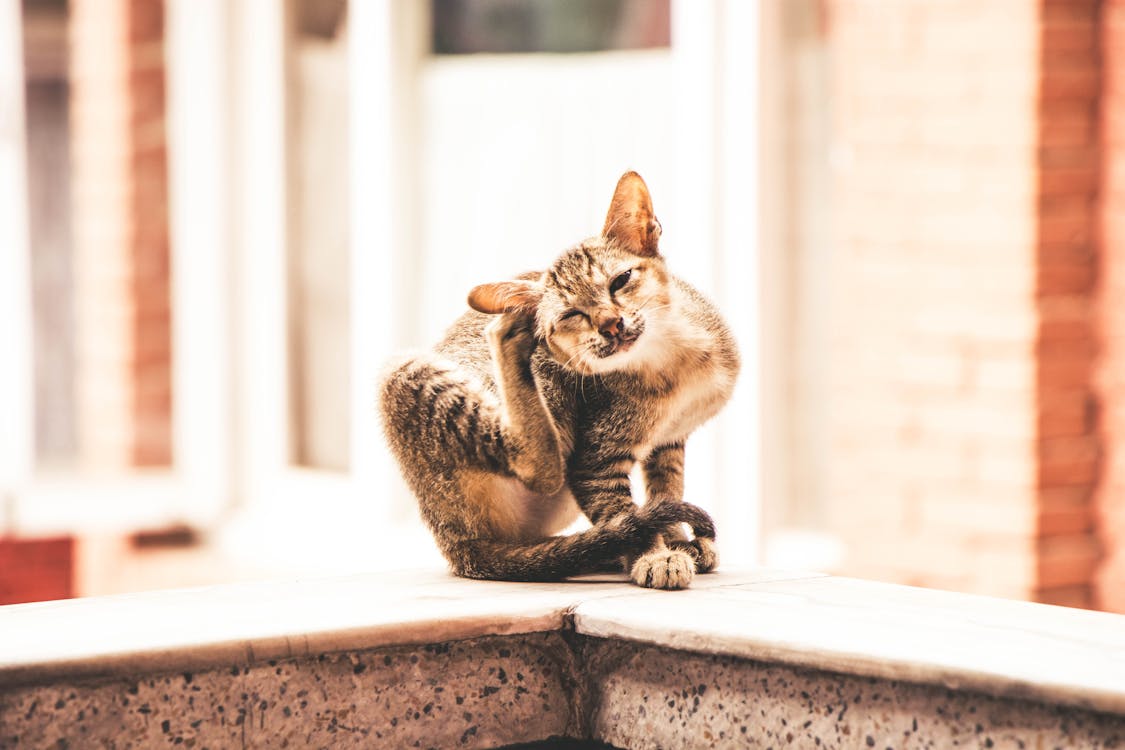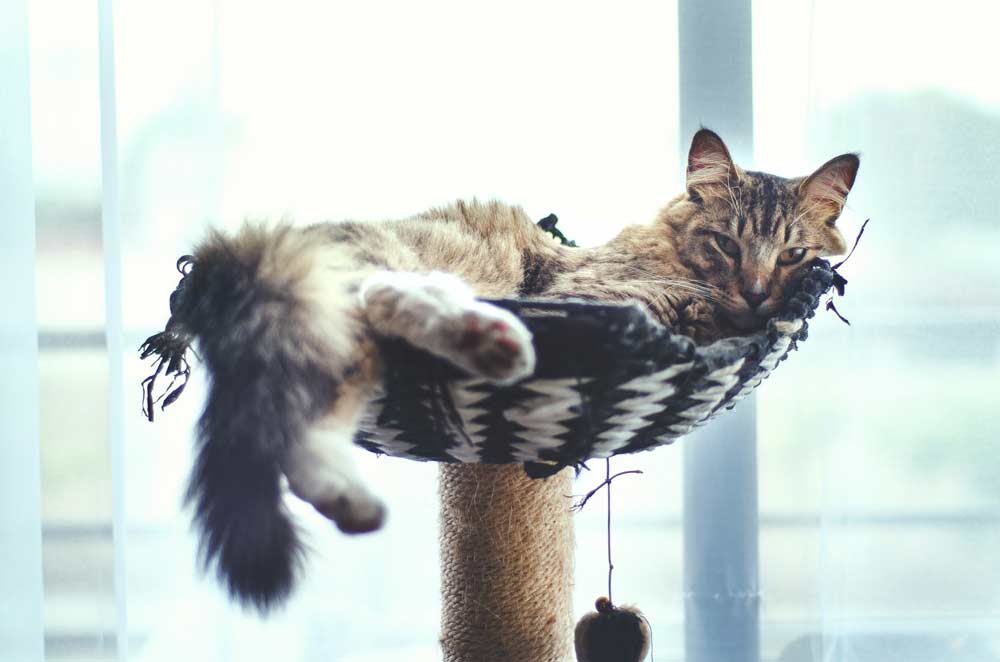How to tell if your cat has fleas and how to help? Ever witness your feline friend engaged in a furious scratching frenzy, leaving you wondering if they’re possessed by a phantom itch or waging war against invisible foes? The culprit might be far more sinister than boredom – fleas, those tiny, bloodsucking parasites, could be making your cat miserable.
Ignoring a flea infestation is not an option. These unwelcome guests not only cause intense discomfort and irritation, but also pose serious health risks to your cat, other pets, and even humans. Don’t let these miniature monsters steal your cat’s purrs and your peace of mind. This article will equip you with the knowledge to become a flea detective, identify the enemy, and devise a battle plan to reclaim your home and your cat’s well-being.
The Flea Files: Unveiling the Enemy
Fleas aren’t all created equal. The most common culprits targeting our feline companions are the aptly named “cat fleas.” These agile jumpers are about 2mm long, reddish-brown, and have powerful legs that propel them onto unsuspecting hosts. But beware, they’re not alone. Dog fleas and even human fleas can occasionally hitch a ride on your cat, causing similar problems.
Fleas have a devious lifecycle. Adult fleas live on your cat, feasting on their blood. They lay eggs that fall off, hatching into larvae that feed on organic debris in your environment. These larvae then spin cocoons and emerge as adult fleas, ready to jump back onto your cat and continue the cycle. This relentless reproduction can quickly lead to a full-blown infestation, leaving your cat itchy, anemic, and potentially harboring tapeworms transmitted by flea bites.
More Than Just a Bite: The Health Risks of Fleas
Fleas aren’t just annoying; they’re downright dangerous. Their bites can trigger allergic reactions in cats, leading to intense itching, hair loss, and painful skin lesions. This constant irritation can also stress your cat, affecting their sleep, appetite, and overall well-being.
The blood loss caused by flea bites can lead to anemia, especially in kittens or senior cats. Additionally, flea bites are the primary mode of transmission for tapeworms, intestinal parasites that can further harm your cat’s health.
But the threat doesn’t stop there. Fleas can easily jump from your cat to other pets in your household, spreading the infestation and multiplying the misery. In rare cases, even humans can experience flea bites, causing itchy bumps and irritation.
Stay tuned for the next section, where we’ll delve into the telltale signs of a flea infestation and equip you with strategies to outsmart these pesky parasites and restore peace to your home!
The Great Feline Scratch: Signs & Symptoms
The most common giveaway? Your cat suddenly resembles a contortionist, contorting themselves into impossible positions for an epic scratching spree. Be on the lookout for:
- Excessive scratching, licking, and biting: This relentless self-grooming isn’t just a spa day; it’s their desperate attempt to combat the itchy irritation caused by flea bites. However, distinguish this from other skin irritations like allergies or dry skin. Look for concentrated areas of scratching, especially around the base of the tail, neck, and back legs.
- Black specks in the fur: Tiny black flecks nestled amongst your cat’s fur might seem like dirt, but don’t be fooled! This could be “flea dirt,” the digested blood of their feast. Grab a white cloth and brush your cat’s fur. If the specks turn reddish-brown when dampened, it’s flea dirt, a telltale sign of their presence.
- Hair loss & redness: Notice bald patches or excessive shedding? Flea bites can trigger hair loss and leave behind red, inflamed skin. While these symptoms can occur with other conditions, their presence alongside scratching and flea dirt strengthens the case for tiny invaders. Remember, a holistic approach is key; consider all the signs together.
Becoming a Flea Sherlock: Detection Methods
Now that you’re armed with the signs, it’s time to put your detective skills to the test!
- The Fine-Toothed Comb: This is your trusty magnifying glass. Run a flea comb through your cat’s fur, focusing on areas like the base of the tail and back legs. Look for any fleas or flea dirt clinging to the comb. Transfer them to a white cloth for a closer look. If you see tiny, jumping insects or reddish-brown specks, congratulations, you’ve found the culprits!
- The Water Test: This is your CSI moment. Place some suspected flea dirt on a damp paper towel. If it turns reddish-brown, it confirms the presence of flea digestive enzymes, a dead giveaway.
- Veterinary Confirmation: While these methods are helpful, seeking professional confirmation from your veterinarian is crucial. They can perform a thorough examination, rule out other causes, and recommend the most effective treatment plan for your feline friend.
Remember, early detection and treatment are key to keeping your cat healthy and flea-free. So, channel your inner Sherlock Holmes, use these detective methods, and say goodbye to those pesky fleas!
Banishing the Beasts: Treatment & Prevention
So you’ve discovered your feline friend might be harboring unwelcome hitchhikers – fleas! Don’t worry, tackling this issue is a multi-pronged approach, and with the right strategy, you can send those blood-sucking pests packing. Here’s your guide to flea treatment and prevention:
Prescription Power: Your veterinarian is your go-to hero in this battle. They can prescribe various safe and effective flea medication options based on your cat’s age, health, and lifestyle. These come in several forms:
- Oral medications: Easy to administer, these chewable tablets or treats kill adult fleas quickly.
- Topical treatments: Applied to your cat’s skin between the shoulder blades, these provide long-lasting protection against all flea stages.
- Injectables: Offering extended protection, these injections are given by your vet and may be suitable for cats who dislike oral medications. How AI, ChatGPT maximizes earnings of many people in minutes
Environmental Warfare: Fleas don’t just live on your cat; their eggs and larvae lurk in your home, waiting to hatch and continue the infestation cycle. Don’t despair! Here’s how to fight back:
- Sprays and foggers: Vet-approved sprays and foggers target flea eggs and larvae hiding in carpets, furniture, and bedding. Follow instructions carefully and ensure proper ventilation.
- Laundering: Wash all your cat’s bedding, toys, and even your clothes and bedding that might have come in contact with them, using hot water and drying on high heat.
- Vacuuming: Vacuum carpets, furniture, and pet resting areas regularly, paying special attention to corners and crevices. Dispose of the vacuum bag immediately after use.
Holistic Approaches: While some natural flea repellents like diatomaceous earth and herbal sprays exist, remember:
- Safety first: Consult your veterinarian before using any natural remedy, as some can be harmful to cats. Motivation – Mind – Success – Thinking – Productivity – Happiness
- Limited effectiveness: Natural options may not be as effective as veterinary-approved treatments, especially for heavy infestations.
- Complementary, not replacements: Consider natural repellents as a supplement to, not a replacement for, vet-recommended treatments.

Preventing the Flea Circus: Long-Term Solutions
Victory over fleas is sweet, but keeping them at bay requires vigilance. Here’s how to make your home a flea-free zone for good:
Regular Checkups & Preventative Medication: Don’t underestimate the power of routine! Take your cat for regular vet checkups, and discuss continuous flea preventive medication. These long-acting treatments ensure year-round protection, stopping flea infestations before they start. Business – Money Making – Marketing – E-commerce
Maintaining a Clean Home: Fleas thrive in messy environments. Combat them by:
- Vacuuming carpets and furniture regularly, especially pet resting areas.
- Washing your cat’s bedding and toys frequently in hot water.
- Controlling potential flea sources like rodents and wildlife around your home.
Multi-Pet Households: Remember, fleas don’t discriminate! If you have multiple pets, make sure all of them receive proper flea prevention to avoid re-infestation. By treating all furry residents and maintaining a clean, flea-unfriendly environment, you can enjoy a peaceful, itch-free home for both you and your feline companions. Health books, guides, exercises, habits, Diets, and more
Beyond the Bite: Emotional & Behavioral Impact
Fleas aren’t just a physical nuisance; they can wreak havoc on your cat’s emotional well-being too. These pesky parasites can trigger:
-
Stress & Anxiety: Constant itching, discomfort, and the feeling of being under attack can cause significant stress and anxiety in your feline friend. Imagine the frustration of having something constantly crawling and biting you – that’s how your cat might feel. This stress can manifest in various ways, from excessive grooming and hiding to aggression and vocalization.
-
Depression: In severe cases, prolonged flea infestations can even lead to depression in cats. Lethargy, loss of appetite, and a general disinterest in activities they once enjoyed could be signs your cat is feeling overwhelmed and hopeless. Fitness – Meditation – Diet – Weight Loss – Healthy Living – Yoga
Restoring Trust & Comfort
Don’t despair! With timely treatment and some TLC, you can help your cat overcome these emotional hurdles and feel safe and loved again. Here are some tips:
- Gentle handling and reassurance: Be extra patient and understanding during treatment. Offer soothing words and gentle petting to build trust and comfort.
- Create a calm environment: Provide quiet spaces with familiar scents and objects where your cat can relax and recuperate. Consider calming diffusers or pheromone sprays to reduce anxiety.
- Positive reinforcement: Reward good behavior with treats, praise, or playtime to counter negative associations with treatment.
The Joy of a Flea-Free Life:
Once your cat is flea-free, you’ll witness a remarkable transformation. Their energy levels will soar, their playful spirit will return, and the constant itching will be a distant memory. You’ll enjoy a renewed sense of peace and connection with your feline companion, knowing they’re happy and healthy. It’s a victory worth celebrating! RPM 3.0 – 60% CONVERSION & Money for Affiliate Marketing
Final thought
Remember, you’re your cat’s advocate. Being vigilant about flea prevention and knowing how to recognize the signs of an infestation empowers you to act quickly and effectively. By following these steps, you can ensure your cat enjoys a flea-free life, brimming with purrs, playtime, and the joys of companionship.
Celebrate the unique bond you share with your feline friend. Their happiness and well-being are in your hands. Be proactive, be aware, and don’t hesitate to seek professional help if needed. Together, you can create a home free of fleas and filled with purrfect memories. Cat accessories on Amazon
So, remember: stay vigilant, act promptly, and prioritize your cat’s well-being. A flea-free future awaits you both!
Other Interesting Articles
- How to Stop A Cat from Spraying after Neutering: 11 Tips
- How to Tell if A Cat is in Pain from Arthritis: How to Help
- 14 Reasons Why Is My Cat Making Weird Purring Noises
- How to Take Care of A Kitten without A Mother: 21 Tips
- What Is Caterwauling? 10 Most Common Reasons Cats Do It
- How to Introduce A Cat To A New Home When Moving?
- Cat Declawing: Tips, FAQs, Health, Alternatives, Pros, Cons
- New Cat? 20 Common Warning Signs When Introducing Cats
- 23 Sure Signs Your Cat May Be in Pain and How to Help It
- How to Stop A Neutered Cat From Spraying: 15 Simple Tips
- 12 Signs Your Cat May Require a Feline Companion
- Feline Pheromones: 12 Ways Calming Cat Pheromones Work
- Do Cats Feel Lonely without Other Cats? 6 Signs of Loneliness
- 10 Reasons Why Cats Hiss: How To Stop The Behavior
- Cat Feeding: Tips, Guide, FAQs, Chart for Kittens to Veterans
- Cat Vaccinations: Schedule, FAQs, Side Effects, and Costs
- 44 Strange, Weird, and Random Cat Behaviors Explained
- 21 Pro Tips for Fostering Kittens: Essential Care Guide
- 18 Cat Sounds Your Feline Makes: What They Mean
- Sexing Kittens: How to Tell, Determine the Sex of Your Kitten



